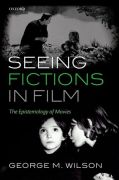
What happens when we view a movie? Do we actually see the fiction, and if so how? Literary fiction is recounted by a voice of some sort--the narrator. George M. Wilson explores the strategies of cinematic narration, and argues that this prompts viewers to imagine seeing and hearing events in the fictional world. In works of literary fiction, it is a part of the fiction that the wordsof the text are being recounted by some work-internal 'voice': the literary narrator. One can ask similarly whether the story in movies is told in sights and sounds by a work-internal subjectivity that orchestrates them: a cinematic narrator. George M. Wilson argues that movies do involve a fictional recounting (an audio-visual narration) in terms of the movie's sound and image track. Viewersare usually prompted to imagine seeing the items and events in the movie's fictional world and to imagine hearing the associated fictional sounds. However,it is much less clear that the cinematic narration must be imagined as the product of some kind of 'narrator' - of a work-internal agent of the narration. Wilsongoes on to examine the further question whether viewers imagine seeing the fictional world face-to-face or whether they imagine seeing it through some kindof work-internal mediation. It is a key contention of this book that only thesecond of these alternatives allows one to give a coherent account of what wedo and do not imagine about what we are seeing on the screen. Having provideda partial account of the foundations of film narration, the final chapters explore the waysin which certain complex strategies of cinematic narration are executed in three exemplary films: David Fincher's Fight Club, von Sternberg's The Scarlet Empress, and the Coen brothers' The Man Who Wasn't There. INDICE: PART I: INTRODUCTORY CHAPTER GENERAL INTRODUCTION NARRATIVE AND NARRATION: SOME RUDIMENTS PART II: NARRATIVES AND NARRATION LE GRAND IMAGIER STEPS OUT: ON THE PRIMITIVE BASIS OF FILM NARRATION THE IMAGINED SEEING THESIS LE GRAND IMAGIER IN REVIEW PART III: NARRATORS: IN LITERATURE AND FILM ELUSIVE NARRATORS IN LITERATURE ELUSIVE NARRATORS IN FILM PART IV: STRATEGIES OF FILM NARRRATION: POINT OF VIEW TRANSPARENCY AND TWIST IN NARRATIVE FILM THE TRANSFIGURATION OF CLASSICAL HOLLYWOOD NORMS: ON VON STERNBERG'S LAST FILMS WITH DIETRICH LOVE AND BULLSHIT IN SANTA ROSA: PASTICHE IN THE COEN BROTHERS' THE MAN WHO WASN'T THERE BIBLIOGRAPHY
- ISBN: 978-0-19-959489-4
- Editorial: Oxford University
- Encuadernacion: Cartoné
- Páginas: 240
- Fecha Publicación: 27/10/2011
- Nº Volúmenes: 1
- Idioma: Inglés
